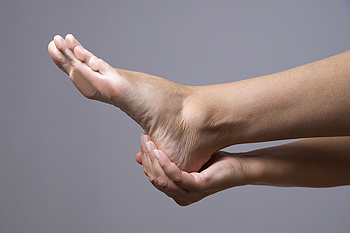Middlefield (860) 349-8500
Wallingford (203) 294-4977
Middlefield (860) 349-8500
Wallingford (203) 294-4977
 A heel spur is defined as a small bony protrusion that extends from the heel to the sole of the foot. Typical reasons for the condition to develop may be due to an injury, which may tear a portion of the heel bone, muscle, or ligament strains. Hard calcium deposits may develop under the heel, gradually forming a heel spur. People who are overweight, or those who participate in running and jumping activities may be more susceptible in developing heel spurs, in addition to those patients who wear shoes that do not fit correctly. There are several symptoms that may accompany this ailment, including pain that is felt in the heel for the majority of the day, inflammation, and tenderness. If you feel you may have a heel spur, it’s suggested to consult with a podiatrist, who can perform a proper diagnosis followed by advice on correct treatment options.
A heel spur is defined as a small bony protrusion that extends from the heel to the sole of the foot. Typical reasons for the condition to develop may be due to an injury, which may tear a portion of the heel bone, muscle, or ligament strains. Hard calcium deposits may develop under the heel, gradually forming a heel spur. People who are overweight, or those who participate in running and jumping activities may be more susceptible in developing heel spurs, in addition to those patients who wear shoes that do not fit correctly. There are several symptoms that may accompany this ailment, including pain that is felt in the heel for the majority of the day, inflammation, and tenderness. If you feel you may have a heel spur, it’s suggested to consult with a podiatrist, who can perform a proper diagnosis followed by advice on correct treatment options.
Heel spurs can be incredibly painful and sometimes may make you unable to participate in physical activities. To get medical care for your heel spurs, contact Dr. Gordon Fosdick from Affiliated Foot Care Center. Our doctor will do everything possible to treat your condition.
Heels Spurs
Heel spurs are formed by calcium deposits on the back of the foot where the heel is. This can also be caused by small fragments of bone breaking off one section of the foot, attaching onto the back of the foot. Heel spurs can also be bone growth on the back of the foot and may grow in the direction of the arch of the foot.
Older individuals usually suffer from heel spurs and pain sometimes intensifies with age. One of the main condition's spurs are related to is plantar fasciitis.
Pain
The pain associated with spurs is often because of weight placed on the feet. When someone is walking, their entire weight is concentrated on the feet. Bone spurs then have the tendency to affect other bones and tissues around the foot. As the pain continues, the feet will become tender and sensitive over time.
Treatments
There are many ways to treat heel spurs. If one is suffering from heel spurs in conjunction with pain, there are several methods for healing. Medication, surgery, and herbal care are some options.
If you have any questions feel free to contact our offices located in Middlefield and Wallingford, CT . We offer the latest in diagnostic and treatment technology to meet your needs.
 The plantar fascia is a long ligament that runs along the bottom of the foot. This ligament is responsible for connecting the heel to the front of the foot, and it supports the foot’s arch. Plantar fasciitis is the number one cause of heel pain. It has been estimated that approximately 2 million people each year are treated for this condition. You will be more likely to develop plantar fasciitis if you are obese, have a high foot arch, are involved in sports, or have tighter calf muscles. Many people who have plantar fasciitis also have heel spurs, but heel spurs are not the cause of plantar fasciitis. Symptoms of plantar fasciitis include pain near the heel, pain after getting up in the morning, and pain after exercising. If you suspect that you may have plantar fasciitis, you should speak with your podiatrist to explore treatment options that could potentially work for you.
The plantar fascia is a long ligament that runs along the bottom of the foot. This ligament is responsible for connecting the heel to the front of the foot, and it supports the foot’s arch. Plantar fasciitis is the number one cause of heel pain. It has been estimated that approximately 2 million people each year are treated for this condition. You will be more likely to develop plantar fasciitis if you are obese, have a high foot arch, are involved in sports, or have tighter calf muscles. Many people who have plantar fasciitis also have heel spurs, but heel spurs are not the cause of plantar fasciitis. Symptoms of plantar fasciitis include pain near the heel, pain after getting up in the morning, and pain after exercising. If you suspect that you may have plantar fasciitis, you should speak with your podiatrist to explore treatment options that could potentially work for you.
Plantar fasciitis can be very painful and inconvenient. If you are experiencing heel pain or symptoms of plantar fasciitis, contact Dr. Gordon Fosdick from Affiliated Foot Care Center. Our doctor can provide the care you need to keep you pain-free and on your feet.
What Is Plantar Fasciitis?
Plantar fasciitis is the inflammation of the thick band of tissue that runs along the bottom of your foot, known as the plantar fascia, and causes mild to severe heel pain.
What Causes Plantar Fasciitis?
How Can It Be Treated?
While very treatable, plantar fasciitis is definitely not something that should be ignored. Especially in severe cases, speaking to your doctor right away is highly recommended to avoid complications and severe heel pain. Your podiatrist can work with you to provide the appropriate treatment options tailored to your condition.
If you have any questions please feel free to contact our offices located in Middlefield and Wallingford, CT . We offer the newest diagnostic and treatment technologies for all your foot and ankle needs.
 Research has shown that when proper foot care is maintained, many foot ailments may be avoided. It may typically begin with choosing shoes that correctly fit your foot. It’s beneficial to have your feet measured before purchasing shoes to ensure you are buying the correct size. This is especially important due to the fact that the feet may change sizes as you age. Additionally, it’s helpful to measure the feet when they are at their largest, and this most often occurs at the end of the day. After you find a comfortable fit, it’s important to make sure there is enough room between your longest toe and the top of the shoe. The feet may feel more comfortable when the material flexible and soft, and conforms to the shape of your foot. If you would like additional information about how to properly fit yourself for shoes, please consult with a podiatrist.
Research has shown that when proper foot care is maintained, many foot ailments may be avoided. It may typically begin with choosing shoes that correctly fit your foot. It’s beneficial to have your feet measured before purchasing shoes to ensure you are buying the correct size. This is especially important due to the fact that the feet may change sizes as you age. Additionally, it’s helpful to measure the feet when they are at their largest, and this most often occurs at the end of the day. After you find a comfortable fit, it’s important to make sure there is enough room between your longest toe and the top of the shoe. The feet may feel more comfortable when the material flexible and soft, and conforms to the shape of your foot. If you would like additional information about how to properly fit yourself for shoes, please consult with a podiatrist.
Getting the right shoe size is an important part of proper foot health. Seek the assistance of Dr. Gordon Fosdick from Affiliated Foot Care Center. Our doctor will provide the care you need to keep you pain-free and on your feet.
Getting the Right Shoe Size
There are many people who wear shoes that are the incorrect size, negatively affecting their feet and posture. Selecting the right shoes is not a difficult process, so long as you keep several things in mind when it comes to choosing the right pair.
As our feet hold our body weight and keep us moving, it is important to treat them right. Picking the right pair of shoes can provide your feet comfort and mobility without pain.
If you have any questions, please feel free to contact our offices located in Middlefield and Wallingford, CT . We offer the newest diagnostic and treatment technologies for all your foot care needs.
 One of the most common injuries the feet can endure may be an ankle sprain. Although this may be a common occurrence among athletes, many people will experience this condition as a result of everyday activities. It happens when the ankle twists unnaturally, and the ligaments and tendons in the foot endure enormous stress. There are several symptoms that are indicative of a sprained ankle including severe pain and discomfort, swelling, and bruising. Some of the more typical reasons why an individual may sprain their ankle may include stepping off a curb that was out of sight, or stepping down with excessive pressure while running. If you feel you have injured your ankle that may have resulted in a sprain, please schedule a consultation with a podiatrist for proper treatment.
One of the most common injuries the feet can endure may be an ankle sprain. Although this may be a common occurrence among athletes, many people will experience this condition as a result of everyday activities. It happens when the ankle twists unnaturally, and the ligaments and tendons in the foot endure enormous stress. There are several symptoms that are indicative of a sprained ankle including severe pain and discomfort, swelling, and bruising. Some of the more typical reasons why an individual may sprain their ankle may include stepping off a curb that was out of sight, or stepping down with excessive pressure while running. If you feel you have injured your ankle that may have resulted in a sprain, please schedule a consultation with a podiatrist for proper treatment.
Ankle sprains are common but need immediate attention. If you need your feet checked, contact Dr. Gordon Fosdick from Affiliated Foot Care Center. Our doctor can provide the care you need to keep you pain-free and on your feet.
How Does an Ankle Sprain Occur?
Ankle sprains take place when the ligaments in your ankle are torn or stretched beyond their limits. There are multiple ways that the ankle can become injured, including twisting or rolling over onto your ankle, putting undue stress on it, or causing trauma to the ankle itself.
What Are the Symptoms?
Preventing a Sprain
Treatment of a Sprain
Treatment of a sprain depends on the severity. Many times, people are told to rest and remain off their feet completely, while others are given an air cast. If the sprain is very severe, surgery may be required.
If you have suffered an ankle sprain previously, you may want to consider additional support such as a brace and regular exercises to strengthen the ankle.
If you have any questions please feel free to contact our offices located in Middlefield and Wallingford, CT . We offer the newest diagnostic and treatment technologies for all your foot and ankle needs.